|
IV.
|

|
The fable of that imaginary inhabitant of the sea, the mermaid, is as old as fable itself.
In one form or another it exists throughout the world. The islanders of the Indian Ocean and the South Sea;
the Esquimaux of the North and the Patagonians of the South, as well as the coasst and maritime nations of the
civilized
world, have each their special version of the tale. It was, unquestionably, the
foundation for the myths of the sirens, tritons, nereids, and the like in classic
antiquity. Science, with its usual pitiless adherence to demonstrable facts, has traced
its origin to those curious marine animals of which the seals and sea-lions are the
most familiar types, but art does not permit science to rob it of its picturesque
material, and with the painters the mermaid retains its legendary shape and
attractiveness, and the world which loves pictures has no occasion to regret the fact. It
has furnished the German artist, William Kray, with a charming motive, which he
most charmingly works out in his "Idyl of the Sea." With him the mermaiden becomes
a mermother, who sports in the waves with her baby mounted on her back. The baby is altogether
human in form, however, so that the picture may safely be
assumed to be founded on the old German legend of the mermaid who married a fisherman, and
bred a human family. In any way it may be interpreted, "An Idyl of the Sea" is
intrinsically a delightful work.
|

|
Quite as realistic as Kray's picture is poetic is "The Awakening," by Ernest Berger, an artist of Berlin.
Here we have the interior of a harem, with a Georgian favorite of the ripest and most alluring
beauty, rousing herself from the nap which she has taken after her bath. Her attitude and
expression have about them the grace suggestive of a cat, when it stretches itself after awakening
from sleep. The painter is a German of entirely modern impulses and methods, rather in sympathy with
the French school than that of his own nation.
|

|
One steps from the harem to the home in the picture
by E. Tobias [A. Tobias], "The Little Housekeeper," a naive and attractive episode of child life, all the
more delightful for the pleasant simplicity with which it is represented.
|

|
"The Double Star," by
Luis Falero, is another of his wonderful adaptations of a suggestion of astronomical science to the uses
of art. The original picture was a sensation of the Salon of 1881.
|
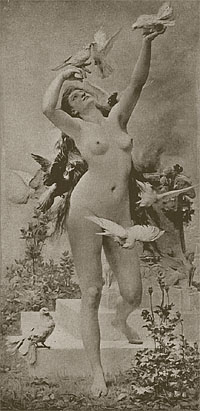
|
When Aphrodite was born of the sea foam,
as the mythologies inform us, she landed at Cythera, which received the newly created
goddess with proper hospitality. She requited this welcome by taking
the island into her favor, and it was made sacred to her, and altars and
temples in her honor erected. From this early associaton, the name Cytheraea was
frequently applied to the patron deity of the place. The artist, Lionel Royer,
was born in the department of Sarthe, at Chateau-du-Loire, and studied art under
Alexander Cabanel. He made his debut as a religious painter, in 1879, with a
picture of "Christ on the Cross," and has since painted chiefly secular historical subjects and
mythological motives. he received his first medal in 1884.
|
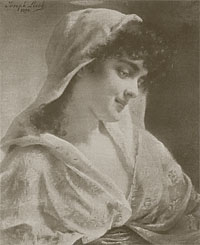
|
Joseph Lieck, of Berlin, is one of the popular German artists of to-day.
He is a Prussian, and a graduate of the Berlin Academy, and has been especially successful in his
delineation of the softer and more tender types of feminine beauty.
|

|
Blaise Bukovac is a Dalmation from Ragusa-Vecchia, born in 1855, but a
thorough Parisian by adoption. He visited France as a student, and enrolled himself
self among the pupils of the Cabanel studio. He has painted many pictures representing famous heroines in a certain class of French novels,
as "Nana," from Zola, "Sappho," from Daudet, "La Grand Iza" from Alexis Bouvier, etc. Much of his
productiveness, however, has been in the line of decorative subjects, for which
his taste and talent peculiarly fit him. Of this, "The Flower" may serve as a capital
indication.
|

|
[two pages missing from book]
|
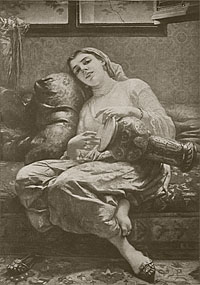
|
The Darbouka Player, Charles Landelle
[text on missing page]
|
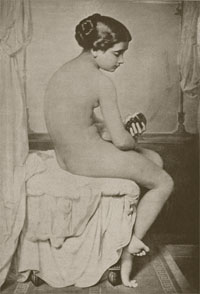
|
An Old Friend, Eugene-Emmanuel Amaury Duval
[text on missing page]
|
p59 - Nathaniel Sichel,
missing
|
[text on missing page]
|
p60 - Gustave Courtois,
missing
|
[text on missing page]
|

|
[two pages missing from book]
the special apartment of the women, where they worked and lunged, and where the children
played. It was the most secluded room in the house, and was jealously guarded from intrusion.
Miss Diana Coomans' picture gives a glimpse at this sanctuary of her sex in a Pompeiian mansion. The
painter is one of two daughters of the late Joseph Coomans, the artist,
and like her sister was a pupil and is a follower of her
father in subjects and methods of painting.
|
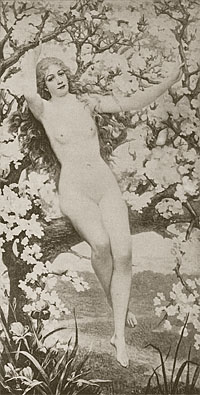
|
"April" is typified
by Jacquesson de la Chevreuse as a lovely woman,
embowered in the blossoms of an apple tree. It was
the picture which represented him in the Salon of 1893, and materially added to his reputation.
|

|
France points with pride to Jules-Joseph Lefebvre
as one of the foremost of her great figure painters, in many points the rival of Boughuereau, and in depth of
sentiment and feeling undoubtedly his superior. Lefebvre was born in the Seineet-Marne, at Tournan, in 1836. At the age of sixteen
he arrived in Paris, bearing a letter of recommendation from Monsignor Salinis, Bishop
of Amiens, to Paulin Guerin, the professor of drawing at the Juilly school. Guerin introduced him to
Leon Cogniet, who received him into his studio, where he commence to study.
His only means of support was a pension granted him by the city of Amiens, of 1,000 francs per
annum for five years. He hoped, before this term expired, to win
the Prix de Rome, but was doomed to disappointment. Three times he competed for the prize and lost it.
At the end of 1859 his pension expired, but he managed to sell a few pictures and paint some portraits.
In 1860 he went up for the Roman prize once more, won it, and in 1861 set out for the Villa Medici,
the headquarters of the French art school in the Eternal City. He received a Fist Medal at the
Salon of 1865, others in 1868 and 1870, and the cross of the Legion of Honor in the later year.
For his exhibits at the Universal Exposition of 1878 he received
a Grand Medal and was made an Officer of the Legion of Honor.
The following year, at the Salon, appeared his "Diana Surprised at the Bath."
|
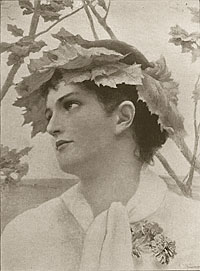
|
A. Seifert, the painter of "Under the Vine Leaves," is one of the younger
generation of German artists who studied and settled in Munich. His pictures enjoy much
popularity in Germany and are widely known through reproductions.
|
|
|
|





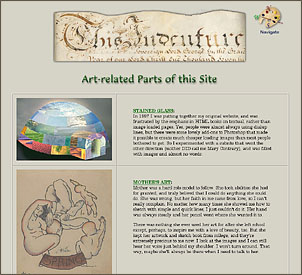



![]() Copyright © 2007, Mary S. Van Deusen
Copyright © 2007, Mary S. Van Deusen